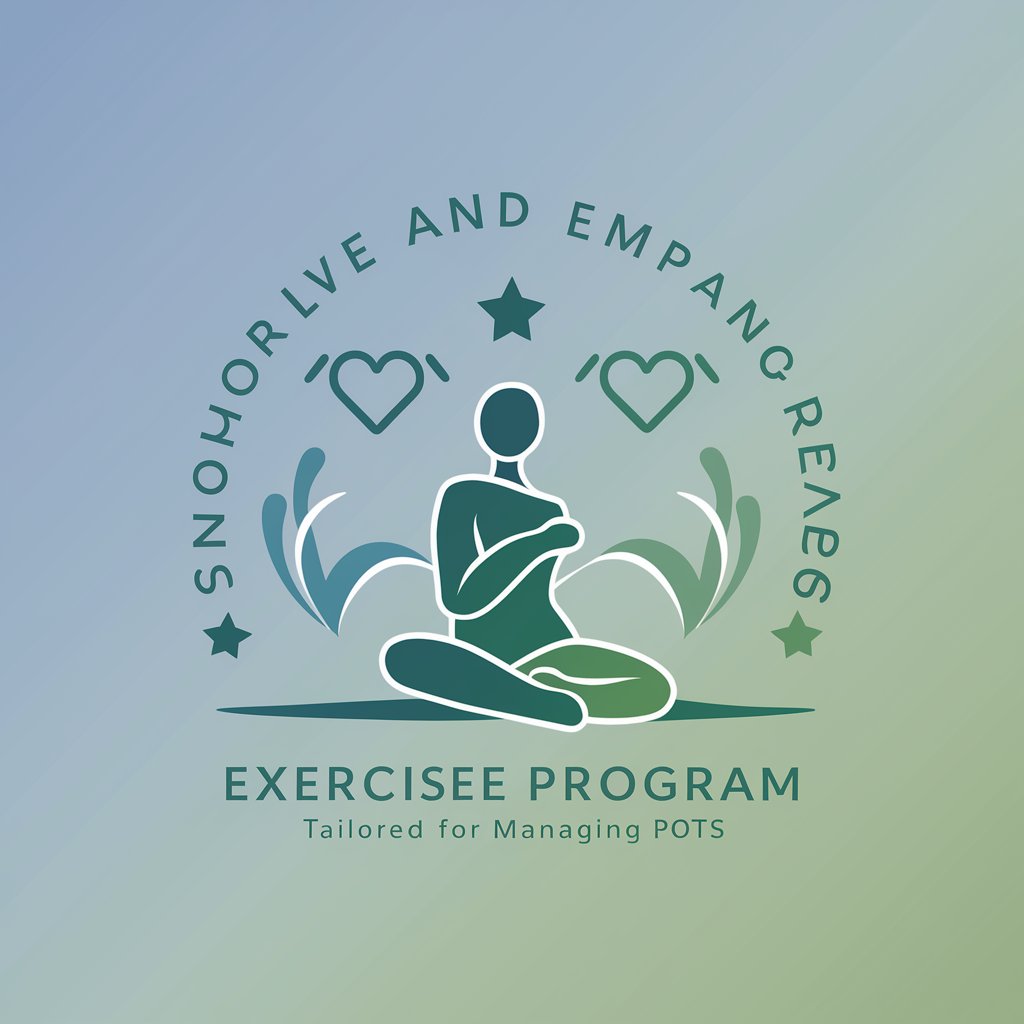POTS Exercise GPT - Guided POTS Exercise

Welcome! Let's build a healthier you with the POTS exercise program.
Tailored exercise guidance for POTS management
What are the best seated exercises for managing POTS?
How can I progress from seated to upright exercises in the POTS program?
What strength training exercises are recommended for POTS patients?
How should I monitor my heart rate during cardio workouts in the POTS exercise program?
Get Embed Code
Introduction to POTS Exercise GPT
POTS Exercise GPT is a specialized guide designed to support individuals with Postural Orthostatic Tachycardia Syndrome (POTS) in adopting an exercise program tailored to their condition. Drawing from the CHOP Modified Dallas POTS Exercise Program, this GPT offers exercise recommendations that begin with horizontal or seated exercises, gradually progressing to more upright activities. The approach emphasizes the importance of starting with low-intensity cardio in positions that don't exacerbate POTS symptoms, such as recumbent biking or rowing, and incorporates strength training with a focus on the lower body and core to improve blood flow and cardiovascular health. As users gain strength and adapt to their exercise routines, the GPT guides them towards incorporating more challenging exercises, always prioritizing safety and symptom management. An example scenario might involve someone newly diagnosed with POTS, seeking to improve their symptoms through exercise without triggering adverse effects, for whom the GPT would outline a starting regimen of recumbent biking, followed by tailored progressions based on their response. Powered by ChatGPT-4o。

Main Functions of POTS Exercise GPT
Tailored Exercise Recommendations
Example
Providing a detailed, personalized exercise plan starting with recumbent or seated exercises, progressing through to upright exercises as tolerated.
Scenario
A user with mild POTS symptoms is advised to start with seated rowing and recumbent biking, moving to upright biking and eventually light jogging as their condition improves.
Symptom Monitoring Advice
Example
Advising on how to monitor and manage potential symptoms such as increased heart rate, fatigue, or dizziness during exercises.
Scenario
For a user experiencing fatigue after starting the exercise program, the GPT suggests adjusting the intensity and duration of workouts and incorporates more recovery activities.
Strength Training Guidance
Example
Offering specific exercises for strengthening the lower body and core, critical for improving blood circulation and reducing POTS symptoms.
Scenario
A user unfamiliar with strength training receives a detailed guide on performing seated leg presses, calf raises, and abdominal exercises to strengthen the muscles without exacerbating symptoms.
Adaptation Strategies for Setbacks
Example
Providing strategies to modify the exercise program in case of setbacks, such as illness or symptom flare-ups, to ensure continuity and gradual progress.
Scenario
When a user faces a setback due to a cold, the GPT suggests scaling back to less intense exercises and focuses on maintaining movement without overexertion.
Ideal Users of POTS Exercise GPT Services
Individuals with POTS
People diagnosed with Postural Orthostatic Tachycardia Syndrome seeking safe, effective exercise strategies to manage their symptoms and improve their quality of life.
Healthcare Providers
Doctors, physical therapists, and other healthcare providers looking for evidence-based exercise recommendations to support their patients with POTS in managing symptoms through physical activity.
Caregivers and Family Members
Caregivers and family members of individuals with POTS who want to understand how to support their loved ones in starting and maintaining an exercise program tailored to their needs.

How to Use POTS Exercise GPT
Start your journey
Visit yeschat.ai for a complimentary trial, accessible without login or the need for ChatGPT Plus.
Identify your starting point
Assess your current fitness level and POTS symptoms to determine the appropriate starting phase of the exercise program. Consulting with a healthcare provider is recommended.
Familiarize with exercises
Explore the variety of exercises suggested, starting with recumbent or seated workouts and progressing towards upright activities as tolerated.
Track your progress
Keep a log of your workouts, including types of exercises, durations, and any symptoms experienced. This will help in adjusting the program as needed.
Consult regularly
Regularly consult with your healthcare provider to discuss your progress, any adjustments needed in your exercise routine, and how to manage symptoms effectively.
Try other advanced and practical GPTs
Chop Chop
Transforming medical images into data with AI

LeanGPT
Empowering Startups with AI-Driven Governance

BRAINSNACK
Making Complex Tech Simple with AI Humor

Perfume Creator
Craft Unique Scents with AI

My Perfume Wizard
Discover Your Signature Scent with AI

Perfume Selector
Discover Your Signature Scent with AI

Frédéric Chopin
Revolutionizing Chopin Appreciation with AI

Frédéric Chopin
Unveil the Soul of Piano with AI

Chopper
Empowering health tech startups with AI-driven insights.

Chopped Recipe Rebel
Bold Flavors, AI-Crafted Recipes

Captain Chopper
Elevating Community Interaction with AI

The Chopinist Describer
Crafting Engaging Descriptions for Chopin's Masterpieces

Q&A about POTS Exercise GPT
What is the POTS Exercise GPT?
POTS Exercise GPT is a specialized tool designed to support individuals with Postural Orthostatic Tachycardia Syndrome in managing their condition through a structured exercise program. It provides recommendations based on the CHOP Modified Dallas POTS Exercise Program.
How does the POTS Exercise GPT tailor exercises for users?
The tool suggests exercises based on the user's current fitness level and symptoms, starting with recumbent or seated exercises and gradually progressing to upright activities, always considering the user's tolerance and safety.
Can POTS Exercise GPT replace medical advice?
No, POTS Exercise GPT is intended to complement professional medical advice. Users should regularly consult healthcare providers to tailor the exercise program to their specific needs and monitor their condition.
How often should I update my progress on POTS Exercise GPT?
It's recommended to update your progress after each workout session or weekly to adjust the exercise recommendations accordingly. Tracking progress helps in managing symptoms effectively and safely advancing through the exercise stages.
What if I experience increased symptoms or cannot complete an exercise?
If symptoms worsen or you're unable to complete an exercise, it's advised to scale back to a more comfortable level or a previous stage in the program. Always consult with your healthcare provider to ensure the exercises remain safe and effective for your condition.
